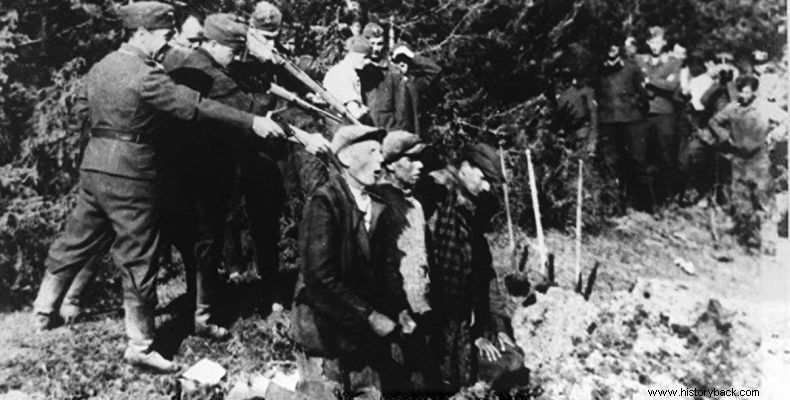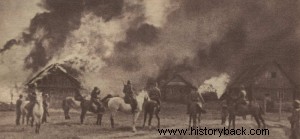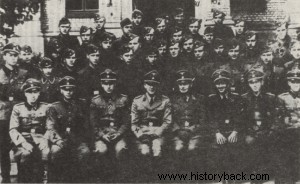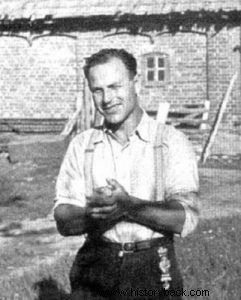
On July 1, 1941, German troops entered the Latvian capital Riga. The SS killers of Einsatzgruppe A, one of the "special" groups that Himmler had set up to "clean up" the rear, also arrived in the area with them.
Head of Einsatzgruppe A it was Walter Stahlecker but he was not alone in his "mission". The German came into contact with a Latvian, German-born police officer, Viktor Arais. This event would have dire consequences for thousands of human lives.
Arais, the son of a German blacksmith, was born in 1910. After his military service, he enrolled in the university's law school but never received a degree. Instead he managed to get appointed to the police. He was an archmaniac and ambitious man with extreme views, pro-German by origin and conviction.
Staleker asked Arajs to set up a "special unit" called "Sonderkommando Arajs" targeting the country's Jews. Within 24 hours Arais had begun recruiting. On July 4 his unit carried out its first "action". Arais and his men locked up 20 Jews, mostly women and children, in the great synagogue of Riga and set fire to the building. Those inside were burned alive.
That was the beginning. But the sequel was much worse. In the department of Arais, they hurried to enlist like-minded people. In the beginning the department numbered about 300 men. Soon its strength increased to 500 and in 1942 it reached 1,500. It was estimated that 80,000 Jews lived in Latvia at that time. The Germans, before the issue of the "final solution" was officially raised, had killed thousands in Poland.
After the conquest of the Baltic countries, it was decided to exterminate all the Jews living there. From about the middle of July and for several months, the men of Arais executed, together with the Germans, Jews in the forest of Bikierneki near Riga. It is estimated that Arais' men killed over 4,000 Jews and 1,000 more pro-Soviet. Arais and his men traveled from village to village in public transport buses, rounding up and killing the Jews.
The massacre in Rubula and the murders in Belarus
By early October 1941, all Latvian Jews were either locked up in ghettos or dead. In late November – early December, together with Einsatzgruppe A Arais and his killers transported 24,000 Jews from the Riga ghetto to the Rubula forest, whom the Germans murdered there. Arais watched the executions in a drunken stupor, while his men grabbed whatever valuables the unfortunate victims carried with them. On another occasion 1,200 Jews were thrown into a lake.
In 1942 the "Sonderkommando Arajs" was sent to fight against Soviet partisans in Belarus. There the men committed unheard of crimes against the just and the unjust, slaughtering, burning, stealing, plundering indiscriminately. The unit also established its own concentration camp outside Riga. Over 2,000 people were murdered there.
For his action, the Germans promoted Arajs to the rank of major in 1943. But then the "Sonderkommando Arajs" was disbanded and its men were transferred to the two Latvian divisions of the Waffen SS, the "Latvian Legion". By then Arais' unit had murdered at least 26,000 people in Latvia and Belarus.
Arais finally managed, in the final stage of the war, to move west and was captured by the British. He remained held in a POW camp until 1949, but was not tried for his crimes. Under a new name – Vitor Czebots – I later worked in West Germany .
However, in 1979 he was recognized and eventually tried and convicted. He died in 1988 in the tax prison in strict isolation. His main prosecution witness was a Jewish survivor of torture and gang-rape by his men, Zelma Sepselovich.
It is worth noting that the supporter and first boy of Arais, Herberts Kukurs, Latvian Air Force pilot, escaped to Brazil. However, he did not escape punishment. In 1965 he was executed by a Mossad agent in Uruguay.

Men of Arais set fire to a village, probably in Belarus.

Men of Arais' unit.

Victor Arais.
